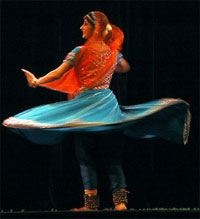|
 Kathak is two-dimensional in character. In the dance, there
is only a front-back treatment of space. Even when
pirouettes are executed, it is long a central vertical median from which no
shifts or deflections take place. The human form is conceived of as a straight
line and there are very few deviations from the vertical median or the Brahmasutra.
The weight of the body in the initial stances of the dance is equally and
the knees are not flexed. The feet, in this position, are invariably in the
sama pada, the first sequence are also executed in the sama pada position.
The complex foot -work can be executed precisely only through a delicate balance
of weight on the flat foot. When the Kathak dancer moves in front, she does
not place the anchita foot forward (hell on the ground) or the kunchita foot
(toe on the ground) she places the flat foot forward lightly, carrying the
weight of the body along rather than shifting the weight tersely. Kathak is two-dimensional in character. In the dance, there
is only a front-back treatment of space. Even when
pirouettes are executed, it is long a central vertical median from which no
shifts or deflections take place. The human form is conceived of as a straight
line and there are very few deviations from the vertical median or the Brahmasutra.
The weight of the body in the initial stances of the dance is equally and
the knees are not flexed. The feet, in this position, are invariably in the
sama pada, the first sequence are also executed in the sama pada position.
The complex foot -work can be executed precisely only through a delicate balance
of weight on the flat foot. When the Kathak dancer moves in front, she does
not place the anchita foot forward (hell on the ground) or the kunchita foot
(toe on the ground) she places the flat foot forward lightly, carrying the
weight of the body along rather than shifting the weight tersely.
The Kathak dancer's alphabet and vocabulary of dance movements are not built
on the principle of either foot contacts or leg extensions or knee flexions.
Nor are the cadences built on the principle of weaving patterns in circles,
semi-circles or figures of 8 of the entire body. The cadences are directly
conditioned by the metrical cycles (talas) on which rhythmic variations can
be executed. Tattakara in Kathak is the ability of the dancer to execute
a variety of rhythmic patterns (jatis) on a basic metrical cycle (tala) |

